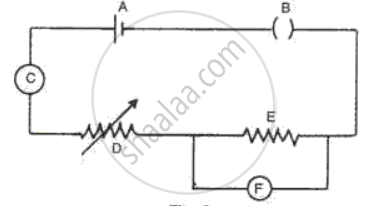Advertisements
Advertisements
प्रश्न
In a conductor 6.25 × `10^16` electrons flow from its end A to B in 2 s. Find the current flowing through the conductor (e = 1.6 × `10^-19` C)
उत्तर
Number of electrons flowing through the conductor,
N = `6.25 × 10^16` electrons
Time taken, t = 2 s
Given, e = `1.6 × 10^-19` C
Let I be the current flowing through the conductor.
Then, I = `"ne"/t`
∴ I = `((6.25 xx 10^16)(1.6 xx10^-19))/2`
= ` 5 xx 10^-3`A
Or, I = 5 mA
Thus, 5 mA current flows from B to A.
APPEARS IN
संबंधित प्रश्न
What will be the change in the current if the potential difference is kept constant and the resistance of the circuit is made four times?
- It will remain unchanged.
- It will become four times.
- It will become one-fourth.
- It will become half.
Name the law which is illustrated by the above V−I graph.
What is the necessary condition for a conductor to obey Ohm’s law?
Which of the following is an ohmic resistance?
Calculate the current flowing through a wire of resistance 5 Ω connected to a battery of potential difference 3 V.
Fig. represents the circuit used for the verification of Ohm's law. Label the parts from A to F. state the function of each.

State Ohm’s law.
A student carries out an experiment and plots the V-I graph of three samples of nichrome wire with resistances R1, R2 and R3 respectively. Which of the following is hue?

A heater of 220 V heats a volume of water m 5 mint time. A heater of 110 V heat in ten second. The resistance of the conductor is
A metal rod of length 10 cm and a rectangular cross-section of 1 cm × `1/2` cm is connected to a battery across opposite faces. The resistance will be ______.
